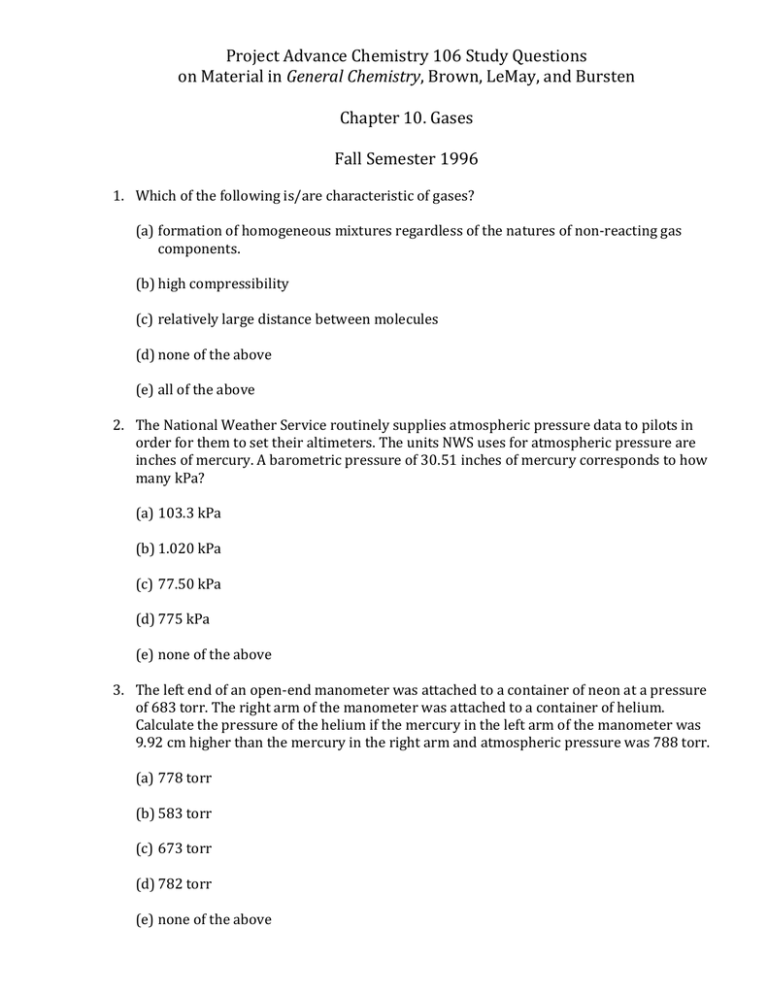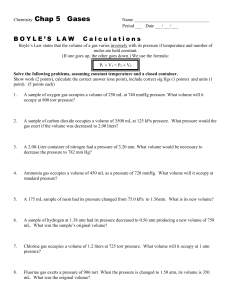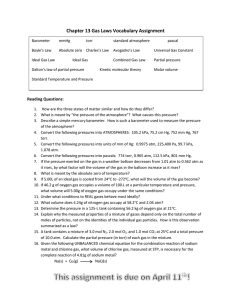96
advertisement

Project Advance Chemistry 106 Study Questions on Material in General Chemistry, Brown, LeMay, and Bursten Chapter 10. Gases Fall Semester 1996 1. Which of the following is/are characteristic of gases? (a) formation of homogeneous mixtures regardless of the natures of non-reacting gas components. (b) high compressibility (c) relatively large distance between molecules (d) none of the above (e) all of the above 2. The National Weather Service routinely supplies atmospheric pressure data to pilots in order for them to set their altimeters. The units NWS uses for atmospheric pressure are inches of mercury. A barometric pressure of 30.51 inches of mercury corresponds to how many kPa? (a) 103.3 kPa (b) 1.020 kPa (c) 77.50 kPa (d) 775 kPa (e) none of the above 3. The left end of an open-end manometer was attached to a container of neon at a pressure of 683 torr. The right arm of the manometer was attached to a container of helium. Calculate the pressure of the helium if the mercury in the left arm of the manometer was 9.92 cm higher than the mercury in the right arm and atmospheric pressure was 788 torr. (a) 778 torr (b) 583 torr (c) 673 torr (d) 782 torr (e) none of the above 4. A gas vessel is attached to an open-tube manometer filled with a nonvolatile liquid of density 0.791 g/mL as shown in the previous question. The difference in heights of the liquid in the two sides of the manometer is 43.4 cm when the atmospheric pressure is 755 mm Hg. Given that the density of mercury is 13.6 g/mL, what is the pressure in atm of the enclosed gas? (a) 0.993 (b) 0.987 (c) 1.03 (d) 0.960 (e) 0.990 5. Which of the following is impossible for a fixed amount of an ideal gas? (a) V1 ___ = T1 (b) V1 __ T2 = V2 (c) V1T1 (d) V2 = V2 ___ T1 ___ T2 = V2T2 T2 ___ V1 T1 (e) none are impossible for an ideal gas. 6. What volume of hydrogen gas at 38°C and 763 torr can be produced by reaction of 4.33 g of zinc with excess sulfuric acid? (a) 1.68 L (b) 2.71 X 10-4 L (c) 3.69 X 104 L (d) 2.84 L (e) none of the above. 7. How many moles of gas occupy 60.82 L at 31°C and 367 mm Hg? (a) 0.120 (b) 0.850 (c) 1.18 (d) 894 (e) 11.6 INSERT CORRECT 8-12 HERE 8. Determine the molecular weight of a gas if 3.5 g of gas occupy 2.1 L at STP. (a) 1.5 (b) 7.5 (c) 0.67 (d) 3.3 (e) none of these. 9. A sample of hydrogen was collected by water displacement at 23.0∪C and an atmospheric pressure of 735 torr. Its volume is 568 mL. After water vapor is removed, what volume would the hydrogen occupy at the same conditions of pressure and temperature? (The vapor pressure of water at 23.0°C is 21 torr). (a) 509 mL (b) 539 mL (c) 552 mL (d) 568 mL (e) 585 mL 10. Which one of the following is not possible for an ideal gas? (b) V1 ___ = T1 V2 ___ T2 (b) V1T1 = V27 (c) V1 __ = T1 ___ V2 T2 (c) none of these. 11. A gas originally at 27°C and 1.00 atm pressure in a 3.9 liter flask is cooled at constant pressure until the temperature is 11°C. What is the new volume of the gas (in liters)? (a) 0.27 (b) 3.7 (c) 3.9 (d) 4.1 (e) none of these. 12. How many moles of gas occupy 60.82 L at 31°C and 367 mm Hg? (a) 1.18 (b) 0.850 (c) 894 (d) 11.6 (e) 0.120 13. Determine the molecular weight of a gas if 3.5 g of gas occupy 2.1 L at STP. (a) 4.6 X 102 (b) 37 (c) 41 (d) 5.5 X 103 (e) none of the above 14. What is the molecular weight of a gas which has a density of 5.75 g/L at STP? (a) 129 (b) 3.90 (c) 578 (d) 141 (e) none of the above 15. A gas mixture of total pressure 4.00 atm and 16.0 total moles contains gases X and Z. If the partial pressure of Z is 2.75 atm, how many moles of X are in the mixture? (a) 5.00 (b) 11.0 (c) 9.25 (d) 6.75 (e) 12.0 16. 3.0 L of He gas at 5.6 atm pressure and 25°C and 4.5 L of Ne gas at 3.6 atm and 25°C are combined at constant temperature into a 9.0 L flask. What is the total pressure (in atm) in the 9.0 L flask? (a) 9.2 (b) 2.6 (c) 3.7 (d) 1.0 (e) none of the above INSERT CORRECT 17-20 HERE 17. Three (30.0) L of an ideal gas in a closed container at 25.0 C and 76.0 mm Hg is heated to 300 C. What is the pressure (in mm Hg) of the gas at this temperature? (a) 912 (b) 146 (c) 76.5 (d) 39.5 (e) none of these. 18. Which of the following gases has a density of 2.104 g/L t 303 K and 1.31 atm? (a) He (b) Ne (c) Ar (d) Kr (e) Xe 19. What is the molecular weight of a gas which has a density of 5.75 g/L at STP? (a) 3.90 (b) 129 (c) 141 (d) 578 (e) none of these. 20. The total pressure of a gas mixture of helium, neon, and argon is 8.40 atm. What is the mole fraction of argon if the respective partial pressures of helium and neon ar 1.50 and 2.00 atm? (a) 0.179 (b) 0.238 (c) 0.357 (d) 0.583 (e) 0.417 21. Absolute zero is the temperature at which (a) gaseous helium liquefies. (b) a straight line graph of P versus 1/V intersects the 1/V axis. (c) a straight line graph of V versus 1/P intersects the 1/P axis. (d) a graph of P versus V at constant T intersects the V axis. (e) a straight line graph of P versus T intersects the T axis. 22. Which one of the following gases will diffuse the fastest at a given temperature? (a) HBr (b) Ar (c) CH4 (d) NH3 (e) UF6 23. Arrange the following gases in order of increasing average molecular speed at 25°C. Cl2, O2, F2, N2 (a) Cl2, F2, N2, O2 (b) Cl2, O2, F2, N2 (c) Cl2, F2, O2, N2 (d) N2, F2, Cl2, O2 (e) Cl2, N2, F2, O2 24. Helium gas (He) effused through a pinhole in 53 seconds. An equivalent amount of an unknown gas, under the same conditions, effused though the hole in 248 seconds. What is the molecular weight of the unknown gas? (a) 18.7 g/mol (b) 88 g/mol (c) 0.18 g/mol (d) 55 g/mol (e) none of these 25. A real gas will behave most like an ideal gas under conditions of (a) low temperature and high pressure (b) high temperature and low pressure (c) low temperature and low pressure (d) high temperature and high pressure





